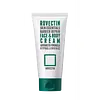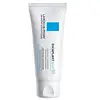What's inside
What's inside
 Key Ingredients
Key Ingredients

 Benefits
Benefits

 Concerns
Concerns

 Ingredients Side-by-side
Ingredients Side-by-side

Water
Skin ConditioningGlycerin
HumectantCaprylic/Capric Triglyceride
MaskingButylene Glycol
HumectantPanthenol
Skin ConditioningPalmitic Acid
EmollientStearic Acid
CleansingHydrogenated Poly(C6-14 Olefin)
EmollientLimnanthes Alba Seed Oil
Skin Conditioning1,2-Hexanediol
Skin ConditioningCeramide NP
Skin ConditioningTocopherol
AntioxidantAstaxanthin
Skin ConditioningPrunus Persica Kernel Oil
EmollientEclipta Prostrata Extract
Skin ConditioningMelia Azadirachta Flower Extract
Skin ConditioningMelia Azadirachta Leaf Extract
Skin ConditioningCurcuma Longa Root Extract
MaskingOcimum Sanctum Leaf Extract
Skin ConditioningCorallina Officinalis Extract
Skin ConditioningMoringa Oleifera Seed Oil
EmollientHydrogenated Vegetable Oil
EmollientHaematococcus Pluvialis Extract
AntioxidantPolyglyceryl-3 Methylglucose Distearate
EmulsifyingPolymethylsilsesquioxane
Pentylene Glycol
Skin ConditioningTromethamine
BufferingAcrylates/C10-30 Alkyl Acrylate Crosspolymer
Emulsion StabilisingCaprylyl Glycol
EmollientEthylhexylglycerin
Skin ConditioningSodium Phytate
Hydrogenated Lecithin
EmulsifyingWater, Glycerin, Caprylic/Capric Triglyceride, Butylene Glycol, Panthenol, Palmitic Acid, Stearic Acid, Hydrogenated Poly(C6-14 Olefin), Limnanthes Alba Seed Oil, 1,2-Hexanediol, Ceramide NP, Tocopherol, Astaxanthin, Prunus Persica Kernel Oil, Eclipta Prostrata Extract, Melia Azadirachta Flower Extract, Melia Azadirachta Leaf Extract, Curcuma Longa Root Extract, Ocimum Sanctum Leaf Extract, Corallina Officinalis Extract, Moringa Oleifera Seed Oil, Hydrogenated Vegetable Oil, Haematococcus Pluvialis Extract, Polyglyceryl-3 Methylglucose Distearate, Polymethylsilsesquioxane, Pentylene Glycol, Tromethamine, Acrylates/C10-30 Alkyl Acrylate Crosspolymer, Caprylyl Glycol, Ethylhexylglycerin, Sodium Phytate, Hydrogenated Lecithin
Water
Skin ConditioningHydrogenated Polyisobutene
EmollientDimethicone 1%
EmollientGlycerin
HumectantButyrospermum Parkii Butter
Skin ConditioningPanthenol
Skin ConditioningAluminum Starch Octenylsuccinate
AbsorbentButylene Glycol
HumectantPropanediol
SolventCetyl PEG/PPG-10/1 Dimethicone
EmulsifyingTrihydroxystearin
Skin ConditioningZinc Gluconate
Skin ConditioningMadecassoside
AntioxidantManganese Gluconate
Skin ConditioningSilica
AbrasiveAluminum Hydroxide
EmollientMagnesium Sulfate
Disodium EDTA
Copper Gluconate
Skin ConditioningCitric Acid
BufferingAcetylated Glycol Stearate
EmollientPolyglyceryl-4 Isostearate
EmulsifyingTocopherol
AntioxidantPentaerythrityl Tetra-Di-T-Butyl Hydroxyhydrocinnamate
AntioxidantSodium Benzoate
MaskingPhenoxyethanol
PreservativeChlorhexidine Digluconate
AntimicrobialTitanium Dioxide
Cosmetic ColorantWater, Hydrogenated Polyisobutene, Dimethicone 1%, Glycerin, Butyrospermum Parkii Butter, Panthenol, Aluminum Starch Octenylsuccinate, Butylene Glycol, Propanediol, Cetyl PEG/PPG-10/1 Dimethicone, Trihydroxystearin, Zinc Gluconate, Madecassoside, Manganese Gluconate, Silica, Aluminum Hydroxide, Magnesium Sulfate, Disodium EDTA, Copper Gluconate, Citric Acid, Acetylated Glycol Stearate, Polyglyceryl-4 Isostearate, Tocopherol, Pentaerythrityl Tetra-Di-T-Butyl Hydroxyhydrocinnamate, Sodium Benzoate, Phenoxyethanol, Chlorhexidine Digluconate, Titanium Dioxide
 Reviews
Reviews

Alternatives
Ingredients Explained
These ingredients are found in both products.
Ingredients higher up in an ingredient list are typically present in a larger amount.
Butylene Glycol (or BG) is used within cosmetic products for a few different reasons:
Overall, Butylene Glycol is a safe and well-rounded ingredient that works well with other ingredients.
Though this ingredient works well with most skin types, some people with sensitive skin may experience a reaction such as allergic rashes, closed comedones, or itchiness.
Learn more about Butylene GlycolGlycerin is already naturally found in your skin. It helps moisturize and protect your skin.
A study from 2016 found glycerin to be more effective as a humectant than AHAs and hyaluronic acid.
As a humectant, it helps the skin stay hydrated by pulling moisture to your skin. The low molecular weight of glycerin allows it to pull moisture into the deeper layers of your skin.
Hydrated skin improves your skin barrier; Your skin barrier helps protect against irritants and bacteria.
Glycerin has also been found to have antimicrobial and antiviral properties. Due to these properties, glycerin is often used in wound and burn treatments.
In cosmetics, glycerin is usually derived from plants such as soybean or palm. However, it can also be sourced from animals, such as tallow or animal fat.
This ingredient is organic, colorless, odorless, and non-toxic.
Glycerin is the name for this ingredient in American English. British English uses Glycerol/Glycerine.
Learn more about GlycerinPanthenol is a common ingredient that helps hydrate and soothe the skin. It is found naturally in our skin and hair.
There are two forms of panthenol: D and L.
D-panthenol is also known as dexpanthenol. Most cosmetics use dexpanthenol or a mixture of D and L-panthenol.
Panthenol is famous due to its ability to go deeper into the skin's layers. Using this ingredient has numerous pros (and no cons):
Like hyaluronic acid, panthenol is a humectant. Humectants are able to bind and hold large amounts of water to keep skin hydrated.
This ingredient works well for wound healing. It works by increasing tissue in the wound and helps close open wounds.
Once oxidized, panthenol converts to pantothenic acid. Panthothenic acid is found in all living cells.
This ingredient is also referred to as pro-vitamin B5.
Learn more about PanthenolTocopherol (also known as Vitamin E) is a common antioxidant used to help protect the skin from free-radicals and strengthen the skin barrier. It's also fat soluble - this means our skin is great at absorbing it.
Vitamin E also helps keep your natural skin lipids healthy. Your lipid skin barrier naturally consists of lipids, ceramides, and fatty acids. Vitamin E offers extra protection for your skin’s lipid barrier, keeping your skin healthy and nourished.
Another benefit is a bit of UV protection. Vitamin E helps reduce the damage caused by UVB rays. (It should not replace your sunscreen). Combining it with Vitamin C can decrease sunburned cells and hyperpigmentation after UV exposure.
You might have noticed Vitamin E + C often paired together. This is because it is great at stabilizing Vitamin C. Using the two together helps increase the effectiveness of both ingredients.
There are often claims that Vitamin E can reduce/prevent scarring, but these claims haven't been confirmed by scientific research.
Learn more about TocopherolWater. It's the most common cosmetic ingredient of all. You'll usually see it at the top of ingredient lists, meaning that it makes up the largest part of the product.
So why is it so popular? Water most often acts as a solvent - this means that it helps dissolve other ingredients into the formulation.
You'll also recognize water as that liquid we all need to stay alive. If you see this, drink a glass of water. Stay hydrated!
Learn more about Water